Three metrics we measured with Blast Motion and what we learned from it
What is Blast?
Blast Motion sensors are a small sensor that attach to the knob of the bat that gives you feedback on the swing through an iPhone (as of publish date, they do not have an android app). They give you a lot of valuable feedback including the players bat speed, time to contact, attack angle, vertical bat angle, connection scores and much more.
Since this was our first year incorporating blast metrics into our program, we decided to focus on three basic statistics; bat speed, time to contact; and attack angle this year.
Blast is a very affordable piece of equipment that we recommend every player and/or every team have access to.
Designing your test
The design of the test if of utmost important. A poorly designed test, or subsequent tests that are not run in the same manner will give you feedback that is either not comparable or that does not represent what the player is actually able to do in game.
The best way you can test your hitters using blast is to test it against live pitching. This will give you the most accurate idea of what is going on with your players swing in games. However, it can be really difficult to run this kind of a test with a large team because of the number of pitchers required to get a large enough sample size to get through all of your hitters.
It will also be difficult to re-run this type of test to look for improvement during your season because many pitchers will be used in games and will be unavailable to pitch in practice.
If you cannot run your assessments/tests against live pitchers, the next two best testing environments are off of a machine at a game distance against game-like velocity or against a mix batting practice from a distance shorter than 60'6 with game-like timing (check out our pitching distance equivalents for batting practice).
It is crucial that if you are testing every 4-6 weeks (which you should) for improvement that you re-test under the same conditions as the initial test as many metrics show up differently under different conditions.
The last two, and least optimal, methods of testing/assessing the swing are off of a tee and against batting practice or front toss without game-like timing. This is not a recommended method of testing and assessing since in game swings will often vary wildly from what players are able to get away with in a less competitive environment.
Specific things we noticed were that as velocity and the competitiveness of the incoming pitch increased, bat speed decreased, time to contact decreased, and attack angle decreased. So hitters were trying to be quicker and more direct to the ball sacrificing power and a proper bat path. This created more ground balls, infield pop-ups, and swings and misses.
Let's take a look at an analysis of the the data we measured this year and how it related to in game performance
Bat Speed
Bat speed has become a very important part of player development over the past several years as we can now measure it easily. Bat speed is a very sexy metric and something that there are proven methods of improving (we even have a 12 week program to create better bat speed) and there is little doubt that a minimum amount of bat speed is required to be competitive at higher levels.
In fact, bat speed can certainly be a limiting factor on success and production of players. We found that all of our hitters who had a good deal of success during the season had bat speeds of at least 63.5 in testing, but not all players above that range were able to have success.
The chart below gives a rough estimate of where we have found successful players fall:
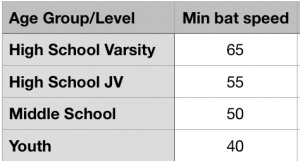 While I certainly still believe that bat speed should be trained, and that a hitter will generally improve if they can improve their bat speed while maintaining their adjustability, quickness, and attack angles, it can also be misleading.
While I certainly still believe that bat speed should be trained, and that a hitter will generally improve if they can improve their bat speed while maintaining their adjustability, quickness, and attack angles, it can also be misleading.
Simply having a high bat speed does not necessarily mean that a hitter will be able compete in game as several of our higher bat speeds this year were not able to crack our line up or were not able to be productive in game during the season.
A lack of bat speed can certainly set a floor for a player, but high bat speeds are just one component of being a good and productive hitter in game.
Time to contact
Blast also measures the amount of time it takes from your initial downward move to the bat contacts the ball. While it would seem like a simple equation of faster is better with time to contact, this is not always the cast.
We found that some players who had very low time to contact (under .14) often did not create a very good attack angle (to be discussed in the next section) or sacrificed bat speed for quickness and were not able to generate much power. So, as with any other stat, this one only tells one piece of what is happening in a swing and must be taken into consideration with the rest of the swing.
This year, we found that our varsity average was .155 seconds and that almost every player who had success in game was at that level or below. Similar to bat speed, not every player below .15 was able to hit successfully in games. Again this only tells one aspect of the swing.
Attack angle
The third major metric we looked at this year was attack angle. Attack angle is defined as the path of the bat on contact relative to the ground. So a downward path would give you a negative number, a perfectly horizontal or flat path would be 0, and an upward path would give you a positive number.
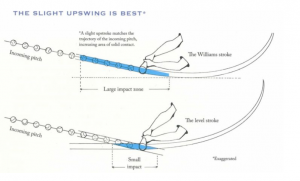
Still don't believe me? Don't take my word for it, take the greatest hitter of all time's word for it!
Blast recommends a bat path of 0 to +15 degrees (or slightly up) in order to match the potential plane of the incoming pitch.
For the purposes of our team, we wanted our players to test within the +5 to +15 degree range in order to try to optimize for hard line drives, to maximize their possible contact time and to maximize the distance their barrel travels through the zone.
When we compared our data test to what happened in our season, we found that all of our top six hitters tested between +4 and +12 degrees. Additionally, any player under 0 degrees or higher than 20 degrees struggled to compete against live pitching in 2019.
Based on our testing, attack angle was one of the more predictive measurements we looked at this year.
Conclusion about the metrics
Based on our data from this our testing this year, plus our in season performances, it is clear that there is no one single metric (of the ones we looked at.. there are many, many more) that will predict a hitters success.
This just reinforced the idea that being a good hitter is SO MUCH MORE than just having a good swing (see our hitting pyramid podcast episode).
We had several hitters with high bat speed who struggled, severeral who had an appropriate attack angle, and several who were quick to contact who struggled as well.
While there was no ONE data point that predicted success, it was very clear, that our top hitters were around or above our team average in all of the metrics we looked at. They had around team average bat speed (65+), they were all between 4 and 12 degrees for their average attack angle, and they were all below average with their time to contact (.155s or faster).
A few things jumped out during out testing that were red flags. We were not able t
Having trouble with what you should do with all of this stuff?
I get it, diagnosing and creating prescriptions for players to improve is difficult business. I just created an entire course for Elite Members called "Diagnosing, Recognizing and Fixing Common Hitting Flaws"
It shows you exactly how to create a hitting assessment for your team with and without technology as well as breaks down how you could recognize what hitters need to work on what aspects of hitting (again with and without technology), then gives specific training methods and drills to use for each hitting flaw.
This is a great course for team coaches who are looking to accomplish the difficult task of bring modern day instruction into a team setting.
**If you purchase your Blast Motion Sensor through this link, I do get a small commission from Amazon off it. IT DOES NOT COST YOU ANYTHING EXTRA. If you are looking at purchasing one, and would like to support our mission, this is a great way to do so while getting a great product.***
More from my site
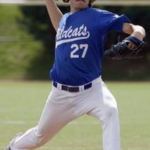 7 points of emphasis in 2015-16 for our pitchers
7 points of emphasis in 2015-16 for our pitchers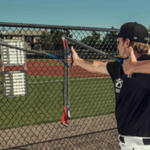 CCA Podcast 018: Post Pitching Recovery Methods
CCA Podcast 018: Post Pitching Recovery Methods CCA Podcast 221 – 4 ways to train more dynamic infielders
CCA Podcast 221 – 4 ways to train more dynamic infielders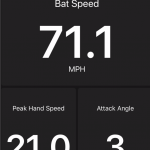 CCA Podcast 160 – Q and A – Utilizing data and metrics at the high school level
CCA Podcast 160 – Q and A – Utilizing data and metrics at the high school level CCA Podcast 088: Handling Slumps
CCA Podcast 088: Handling Slumps CCA Podcast 216 – Rich Benjamin Indiana Wesleyan Part 2
CCA Podcast 216 – Rich Benjamin Indiana Wesleyan Part 2
 Posted by Kyle Nelson
Posted by Kyle Nelson- Posted in Hitting
 Jul, 29, 2019
Jul, 29, 2019 No Comments.
No Comments.
Elite members login here
Check out what’s New/Hot!
Recognizing, Diagnosing, and Fixing Common Hitting Flaws eCourse The 3 metrics we tested on Blast motion sensors this year Sneak Peek Inside an Elite Q and A The batting practice continuum Elite Member’s area table of contents 50+ “Chaos” hitting drills
5 sample Chaos hitting drills FREE
Mental Skills and Culture Building The hitting pyramid Welcome Elite Member, Trey! Ideas for a pitcher first practice 12 week bat speed improvement plan Make plans this offseason to have your team playing their best baseball at the end of the year” Top 5 hitting drills to translate practice skill to game performanceHow we used Blast Motion sensors with a team in 2019
What to do if your hitters are overmatched Welcome Elite Member, Tommy! Setting your baserunners up for success Welcome Elite Member, Mike! A consulting call with Elite Member Matt FREE Web Clinic: Developing Athletic, Consistent, Extraordinary Infielders
 Coach Kyle Nelson
Coach Kyle Nelson